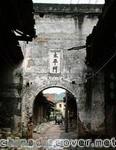
Daxu town is one of the four famous ancient towns in Guangxi province with a history over 1000 years. It is located on the north bank of the Li River, about 29km by river from Guilin.
A 2.3km-long and 2m-wide stone street runs through the town with various ancient buildings lining both sides, old residences, shops and stalls, the ancient town keeps in its antique style from the Ming Dynasty (1368-1644). These structures, mainly form the Ming and Qing dynasties, are famous for their magnificence, refinement and practicality.
The old street was paved with dark green quadrate limestones that have been ground and washed smooth by shoes, carts and rain. Some well-preserved residences hidden behind the street door may give you surprises you when you occasionally explore further into a shop.
Over the past centuries, before the railway system was built, it had been one of Li river's four most important harbours. Most of its inhabitants were traders and Daxu's market was well-known all over southern China. It was a busy trading center in the old times. The town came into being in around 200 B.C. Since the Emperor Qin Shi Huang built the Ling Canal which linked Xiang River of the Yangtze River water system with Li River of the Pearl River water system, this lucrative water route played a more and more important role in transportation and Daxu, the town lying by Li River, became a place and a port of collecting and distributing goods. There are still 13 docks along the old street from which you can imagine its prosperity in former days. The town was getting quiet since 1930s when railways and highroads replaced river shipping.
After that, with the construction of the railway system, river transport decreased drastically and Daxu fell into a decadent sleep. As it is the only village on the eastern side of the river, it escaped from massive tourist exploitation. But many local residents still keep their traditional handcraft and business, such as in-home workshops of rice wine, carpenters, bamboo baskets and in-home traditional Chinese medical clinics. There are about 20 clinics gathered along the street, some of which specialize in gynecology  and some in paediatrics. Coming into the clinic, you can smell the scent of medical herbs and timeworn medicine chests tell the history of the clinic. The rice wine workshop remains the old way of brewing wines by using old barrels, baskets and distillery.
and some in paediatrics. Coming into the clinic, you can smell the scent of medical herbs and timeworn medicine chests tell the history of the clinic. The rice wine workshop remains the old way of brewing wines by using old barrels, baskets and distillery.
People in the town are very kind to tourists. There is a single-arched bridge in the town named Longevity Bridge. The simple and elegant Longevity Bridge, built during the Ming dynasty, is located on the south side of town.
The commerce in Daxu town first appeared in the Song dynasty and flourished at the end of the Qing dynasty. On the market day, thousands of people, with their own products, go to the fair. Noisy and busy, trade becomes the theme of the day. Opposite the town on the other side of the river, a millstone-like rock with the running waters creates the scene of Grinding Grain.
